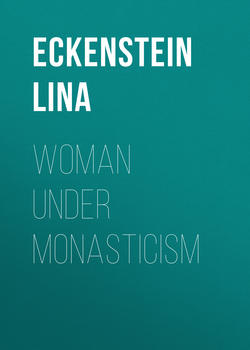Woman under Monasticism

Реклама. ООО «ЛитРес», ИНН: 7719571260.
Оглавление
Eckenstein Lina. Woman under Monasticism
PREFACE
CHAPTER I. INTRODUCTORY
§ 1. The Borderland of Heathendom and Christianity
§ 2. The Tribal Goddess as a Christian Saint
§ 3. Further Peculiarities of this Type of Saint
CHAPTER II. CONVENTS AMONG THE FRANKS, A.D. 550-650
§ 1. At the Frankish Invasion140
§ 2. St Radegund and the Nunnery at Poitiers
§ 3. The Revolt of the Nuns at Poitiers201. Convent Life in the North
CHAPTER III. CONVENTS AMONG THE ANGLO-SAXONS, A.D. 630-730
§ 1. Early Houses in Kent
§ 2. The Monastery at Whitby258
§ 3. Ely and the influence of Bishop Wilfrith
§ 4. Houses in Mercia and in the South
CHAPTER IV. ANGLO-SAXON NUNS IN CONNECTION WITH BONIFACE
§ 1. The Women corresponding with Boniface
§ 2. Anglo-Saxon Nuns abroad
CHAPTER V. CONVENTS IN SAXON LANDS BETWEEN A.D. 800-1000
§ 1. Women’s Convents in Saxony
§ 2. Early History of Gandersheim463
§ 3. The Nun Hrotsvith and her Writings476
CHAPTER VI. THE MONASTIC REVIVAL OF THE MIDDLE AGES
§ 1. The new Monastic Orders
§ 2. Benedictine Convents in the Twelfth Century
§ 3. The Order of St Gilbert of Sempringham589
CHAPTER VII. ART INDUSTRIES IN THE NUNNERY
§ 1. Art Industries generally
§ 2. Herrad and the ‘Garden of Delights.’
CHAPTER VIII. PROPHECY AND PHILANTHROPY
§ 1. St Hildegard of Bingen671 and St Elisabeth of Schönau672
§ 2. Women-Saints connected with Charity and Philanthropy
CHAPTER IX. EARLY MYSTIC LITERATURE
§ 1. Mystic writings for women in England
§ 2. The Convent of Helfta and its Literary Nuns808
CHAPTER X. SOME ASPECTS OF THE CONVENT IN ENGLAND DURING THE LATER MIDDLE AGES
§ 1. The External Relations of the Convent
§ 2. The Internal Arrangements of the Convent
§ 3. The Foundation and Internal Arrangements of Sion950
CHAPTER XI. MONASTIC REFORM PREVIOUS TO THE REFORMATION
§ 1. Visitations of Nunneries in England
§ 2. Reforms in Germany
CHAPTER XII. THE DISSOLUTION
§ 1. The Dissolution in England
§ 2. The Memoir of Charitas Pirckheimer
CONCLUSION
APPENDIX
Отрывок из книги
In order to gain an insight into the causes of the rapid development of monasticism among the German races, it is necessary to enquire into the social arrangements of the period which witnessed the introduction of Christianity, and into those survivals of the previous period of social development which German Christianity absorbed. Among peoples of German race monastic life generally, and especially monastic life which gave scope for independent activity among women, had a development of its own. Women of the newly-converted yet still barbarian race readily gathered together and dwelt in religious settlements founded on their own initiative and ruled independently of men. A reason for this must be sought in the drift of contemporary life, which we shall thus have to discuss at some length.
During the period of declining heathendom – for how long, measuring time by centuries, it is not yet possible to say – the drift of society had been towards curtailing woman’s liberty of movement and interfering with her freedom of action. When the Germans crossed the threshold of history the characteristics of the father-age were already in the ascendant; the social era, when the growing desire for certainty of fatherhood caused individual women and their offspring to be brought into the possession of individual men, had already begun. The influence of women was more and more restricted owing to their domestic subjection. But traditions of a time when it had been otherwise still lingered.
.....
‘It seems well,’ he says, in the opening of his chapter on goddesses, ‘to treat of goddesses collectively as well as individually, since a common conception underlies them all, which will thus stand out the more clearly. They are conceived essentially as divine mothers, travelling about and visiting mortals, from whom mankind learn the ways and arts of housekeeping and tilth: spinning, weaving, guarding the hearth, sowing and reaping’ (the italics are his).
The tendency of the goddess to wander from place to place is reflected in many women pseudo-saints who are represented in their legends as inhabiting at various periods of their lives different parts of the district in which they are the object of veneration. Verena of northern Switzerland dwelt first at Solothurn, where a cave, which was her dwelling-place, is now transformed into a chapel. Later she took boat to the place where the Aar, Reuss and Limmat meet, where she dwelt in solitude, and her memory is preserved at a spot called the cell of Verena (Verenazell). Later still she went to dwell at Zurzach, a place which was celebrated for a fair, called Verena’s fair, of which more anon. All these places are on or near the river Aar, at no inconsiderable distance from each other. The legend, as told by Stadler, takes them all into account, explaining how Verena came to be connected with each47.
.....